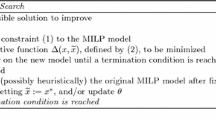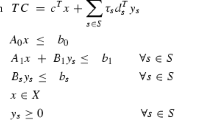Abstract
This paper proposes a multi-time period, two-stage stochastic programming model for the design and management of a typical combat logistics problem. The design shall minimize the total path setup cost, commodity preposition and processing costs, and expected transportation, storage, and shortage costs across all possible path failure scenarios. Due to the complexity associated with solving the model, we propose an accelerated Benders decomposition algorithm to solve the model in a realistic-size network problem within a reasonable amount of time. The Benders decomposition algorithm incorporates several algorithmic improvements such as pareto-optimal cuts, multi-cuts, knapsack inequalities, integer cuts, input ordering, mean-value cuts, and the rolling horizon heuristic. Computational experiments are performed to assess the efficiency of different enhancement techniques within the Benders decomposition algorithm.



Similar content being viewed by others
Notes
This is primarily due to the fact that over time the attacker will realize the adopted strategies undertaken by the combat logistics network. Therefore, it is mandatory for the combat logistic network planner to account for this factor while designing for the overall combat operations.
This can be achieved via dropping the capacity of the susceptible paths \(u_{ijp}\) by multiplying them with a \(\beta _{ijp}\) value less than 1.0, i.e., \(\beta _{ijp} < 1\) in \(u_{ijp}\beta _{ijp}\). See constraint (7) for details.
Three different path failure probability scenarios have been constructed for this case; however, the decision maker can construct additional groups by further classifying the failure scenarios (e.g., low-medium/high-medium path failure scenario grouping and the like).
References
Ahner DK, Parson CR (2015) Optimal multi-stage allocation of weapons to targets using adaptive dynamic programming. Optimization Letters 9(8):1689–1701. https://doi.org/10.1007/s11590-014-0823-x
Akgün I, Tansel BÇ (2007) Optimization of transportation requirements in the deployment of military units. Computers and Operations Research 34(4):1158–1176. https://doi.org/10.1016/j.cor.2005.06.016
Andersen J, Crainic TG, Christiansen M (2009) Service network design with asset management: Formulations and comparative analyses. Transportation Research Part C 17(2):197–207. https://doi.org/10.1016/j.trc.2008.10.005
Balasubramanian J, Grossmann I (2004) Approximation to multistage stochastic optimization in multiperiod batch plant scheduling under demand uncertainty. Industrial and Engineering Chemistry Research 43(14):3695–3713. https://doi.org/10.1021/ie030308+
Barahona F, Chowdhary P, Ettl M, Huang P, Kimbrel T, Ladanyi L, Lee YM, Schieber B, Sourirajan K, Sviridenko M, Swirszcz GM (2007) Inventory allocation and transportation scheduling for logistics of network-centric military operations. IBM Journal of Research and Development 51(3/4):391–407. https://doi.org/10.1147/rd.513.0391
Batun S, Denton BT, Huschka TR, Schaefer AJ (2011) Operating room pooling and parallel surgery processing under uncertainty. INFORMS Journal on Computing 23(2):220–237. https://doi.org/10.1287/ijoc.1100.0396
Benders JF (1962) Partitioning procedures for solving mixedvariables programming problems. Numerische Mathematik 4:237–252. https://doi.org/10.1007/BF01386316
Birge JR, Louveaux FV (1988) A multicut algorithm for two-stage stochastic linear programs. European Journal of Operational Research 34(3):384–392. https://doi.org/10.1016/0377-2217(88)90159-2
Brown GG, Carlyle WM (2008) Optimizing the US Navy’s combat logistics force. Naval Research Logistics (NRL) 55(8):800–810. https://doi.org/10.1002/nav.20318
CPLEX. (2016). Benders algorithm in CPLEX V12.7.0. Retrieved from: https://www.ibm.com/support/knowledgecenter/en/SSSA5P_12.7.0/ilog.odms.cplex.help/CPLEX/ReleaseNotes/topics/releasenotes127/newBenders.html
Crainic TG, Rousseau JM (1986) Multicommodity, multimode freight transportation: A general modeling and algorithmic framework for the service network design problem. Transportation Research Part B 20(3):225–242. https://doi.org/10.1016/0191-2615(86)90019-6
Errico F, Crainic TG, Malucelli F, Nonato M (2016) A Benders decomposition approach for the symmetric TSP with generalized latency arising in the design of semiflexible transit systems. Transportation Science 51(2):706–722. https://doi.org/10.1287/trsc.2015.0636
Faied, M., & Girard, A. (2010). Modeling and optimizing military air operations. In Proceedings of the 48th IEEE conference on decision and control (pp. 6274–6279). https://doi.org/10.1109/CDC.2009.5399926
Fischetti M, Lodi A (2003) Local branching. Mathematical Programming 98:23–47. https://doi.org/10.1007/s10107-003-0395-5
Fulton LV, Lasdon LS, McDaniel RR Jr, Coppola MN (2010) Two-stage stochastic optimization for the allocation of medical assets in steady-state combat operations. The Journal of Defense Modeling and Simulation 7(2):89–102. https://doi.org/10.1177/1548512910364390
Gendron B, Crainic TG, Frangioni A (1999) Multicommodity capacitated network design. Springer, Berlin, pp 1–19. https://doi.org/10.1007/978-1-4615-5087-7_1
General Algebraic Modeling System. (GAMS). (2013). Retrieved from: http://www.gams.com/
Georgiadis MC, Tsiakis P, Longinidis P, Sofioglou MK (2011) Optimal design of supply chain networks under uncertain transient demand variations. Omega 39(3):254–272. https://doi.org/10.1016/j.omega.2010.07.002
Gue KR (2003) A dynamic distribution model for combat logistics. Computers and Operations Research 30(3):367–381. https://doi.org/10.1016/S0305-0548(01)00104-6
Jans R, Desrosiers J (2013) Efficient symmetry breaking formulations for the job grouping problem. Computers and Operations Research 40(4):1132–1142. https://doi.org/10.1016/j.cor.2012.11.017
Kleywegt AJ, Shapiro A, Homem-De-Mello T (2001) The sample average approximation method for stochastic discrete optimization. SIAM Journal of Optimization 12:479–502. https://doi.org/10.1137/S1052623499363220
Kostina AM, Guillen-Gosalbeza G, Meleb FD, Bagajewiczc MJ, Jimeneza L (2011) A novel rolling horizon strategy for the strategic planning of supply chains. Application to the sugar cane industry of Argentina. Computers and Chemical Engineering 35:2540–2563. https://doi.org/10.1016/j.compchemeng.2011.04.006
Magnanti TL, Wong RT (1981) Accelerating Benders decomposition: Algorithmic enhancement and model selection criteria. Operations Research 29:464–484. https://doi.org/10.1287/opre.29.3.464
Magnanti TL, Wong RT (1984) Network design and transportation planning: Models and algorithms. Transportation Science 18(1):1–55. https://doi.org/10.1287/trsc.18.1.1
Mak WK, Morton DP, Wood RK (1999) Monte Carlo bounding techniques for determining solution quality in stochastic programs. Operations Research Letters 24:47–56. https://doi.org/10.1016/S0167-6377(98)00054-6
Marufuzzaman M, Eksioglu SD (2017) Designing a reliable and dynamic multi-modal transportation network for biofuel supply chain. Transportation Science 51(2):494–517. https://doi.org/10.1287/trsc.2015.0632
NATO. (2012). Logistics handbook. Retrieved from: https://www.nato.int/nato_static_fl2014/assets/pdf/pdf_2016_03/20160303_2012-logistics_hndbk-en.pdf
National Priorities Project. (2018a). Military spending in the United States. Retrieved from: https://www.nationalpriorities.org/campaigns/military-spending-united-states/
National Priorities Project. (2018b). Overseas contingency operations: The Pentagon slush fund. Retrieved from https://www.nationalpriorities.org/campaigns/overseas-contingency-operations/
Norkin VI, Ermoliev YM, Ruszczynski A (1998) On optimal allocation of indivisibles under uncertainty. Operations Research 46:381–395. https://doi.org/10.1287/opre.46.3.381
Norkin VI, Pflug GC, Ruszczynski A (1998) A branch and bound method for stochastic global optimization. Mathematical Programming 83(3):425–450. https://doi.org/10.1007/BF02680569
Office of Management and Budget. (2017). America first: A budget blueprint to make America great again. Retrieved from https://www.gpo.gov/fdsys/pkg/BUDGET-2018-BLUEPRINT/pdf/BUDGET-2018-BLUEPRINT.pdf
Overholts DL II, Bell JE, Arostegui MA (2009) A location analysis approach for military maintenance scheduling with geographically dispersed service areas. Omega 37(4):838–852. https://doi.org/10.1016/j.omega.2008.05.003
Papadakos N (2008) Practical enhancements to the magnanti-wong method. Operations Research Letters 36:444–449. https://doi.org/10.1016/j.orl.2008.01.005
Ren, J., Zheng, X. L., & Tan, Y. J. (2013). Multi-product supply planning for combat units in battlefield environment. In The 19th international conference on industrial engineering and engineering management (pp. 445–453). https://doi.org/10.1007/978-3-642-37270-4_43
Rettke AJ, Robbins MJ, Lunday BJ (2016) Approximate dynamic programming for the dispatch of military medical evacuation assets. European Journal of Operational Research 254(3):824–839. https://doi.org/10.1016/j.ejor.2016.04.017
Santoso T, Ahmed S, Goetschalckx M, Shapiro A (2005) A stochastic programming approach for supply chain network design under uncertainty. European Journal of Operational Research 167:96–115. https://doi.org/10.1016/j.ejor.2004.01.046
Schutz P, Tomasgard A, Ahmed S (2009) Supply chain design under uncertainty using sample average approximation and dual decomposition. European Journal of Operational Research 199:409–419. https://doi.org/10.1016/j.ejor.2008.11.040
Sebbah S, Ghanmi A, Boukhtouta A (2013) A column-and-cut generation algorithm for planning of Canadian armed forces tactical logistics distribution. Computers and Operations Research 40(12):3069–3079. https://doi.org/10.1016/j.cor.2013.07.002
Toyoglu H, Karasan OE, Kara BY (2011) Distribution network design on the battlefield. Naval Research Logistics (NRL) 58(3):188–209. https://doi.org/10.1002/nav.20402
Tsadikovich D, Levner E, Tell H, Werner F (2016) Integrated demand-responsive scheduling of maintenance and transportation operations in military supply chains. International Journal of Production Research 54(19):5798–5810. https://doi.org/10.1080/00207543.2016.1178864
Verweij B, Ahmed S, Kleywegt AJ, Nemhauser G, Shapiro A (2003) The sample average approximation method applied to stochastic routing problems: A computational study. Computational Optimization and Applications 24:289–333. https://doi.org/10.1023/A:1021814225969
Acknowledgements
This material is based upon work supported by the U.S. Army TACOM Life Cycle Command under Contract No. W56HZV-08-C-0236. Any opinions, findings, and conclusions or recommendations expressed in this material are those of the author(s) and do not necessarily reflect the views of the U.S. Army TACOM Life Cycle Command.
Author information
Authors and Affiliations
Corresponding author
Additional information
Publisher's Note
Springer Nature remains neutral with regard to jurisdictional claims in published maps and institutional affiliations.
Appendices
Appendix A
1.1 Input ordering
Jans and Desrosiers (2013) observed that the order in which the input data are loaded into the model can have a major impact on the linear programming (LP) relaxation, node exploration, and ultimately the solution time. We use this concept to order some input parameters while solving [RMP]. To the best of the authors’ knowledge, we are the first to apply an input ordering concept in solving a Benders master problem. The idea lies in the fact that assigning critical combat nodes first may help solvers (e.g., CPLEX, Gurobi) to obtain the lower bound quickly. Based on the structure of our problem, we propose two different ways to sort the input data, besides random ordering obtained from the initial data instances.
Customer demand\(d_{mjt}\)sorting: This technique ranks the combat nodes according to their commodity demand throughout the entire planning horizon. The nodes with higher demands will be ranked first in the input file in an attempt to quickly obtain a lower bound for [RMP].
Risk parameter, \(\beta _{ijpt}\), sorting: This technique sorts the paths \(p \in {\mathcal {P}}\) between supply sites \(i \in {\mathcal {I}}\) and combat nodes \(j \in {\mathcal {J}}\) based on their average risk values \({\overline{\beta }}_{ijpt}\) throughout the entire planning horizon. The paths with lower risk values will be sorted first in the input file in an attempt to quickly obtain a lower bound for [RMP].
The last set of experiments examine the impact of input order technique on solving Benders master problem [RMP] and the overall algorithmic performance. Table 9 presents the impact of customer demand \(d_{mjt}\) and risk parameter \(\beta _{ijpt}\) sorting on overall Benders decomposition algorithm. We use Type D+PO+Integer variant of the Benders decomposition algorithm (see Table 5) and set sample size \(N = 50\) to run these experiments. Note although the results produced by the Type D+PO+Integer+RH algorithm in Table 5 are encouraging (with respect to both running time and optimality gap), we still decided to carry forward with Type D+PO+Integer algorithm in Table 9 primarily due to its ability to produce a valid optimality gap for the overall problem CLM. Results indicate that both \(d_{mjt}\) and \(\beta _{ijpt}\) sorting provide slightly better computational performance in solving Benders decomposition algorithm over random sorting. Results in Table 9 indicate that the average running time of the Type D+PO+Integer variant of the Benders decomposition algorithm can be dropped down to 5804 and 5893 CPU seconds, respectively, from 5956 CPU seconds if \(d_{mjt}\) and \(\beta _{ijpt}\) input ordering are applied over random ordering. Note that between \(d_{mjt}\) and \(\beta _{ijpt}\) ordering, \(d_{mjt}\) demonstrates slightly higher computational performance over \(\beta _{ijpt}\). This may be due to the fact that the nodes with higher demands, once explored by the solver, may generate a quick lower bound in solving [RMP] of the Benders decomposition algorithm. Overall, we observe that instead of using random ordering, input ordering on specific parameters (e.g., \(d_{mjt}\), \(\beta _{ijpt}\)) slightly improves the computational performance of the basic Benders decomposition algorithm.
Appendix B
See Table 10.
Rights and permissions
About this article
Cite this article
Marufuzzaman, M., Nur, F., Bednar, A.E. et al. Enhancing Benders decomposition algorithm to solve a combat logistics problem. OR Spectrum 42, 161–198 (2020). https://doi.org/10.1007/s00291-019-00571-y
Received:
Accepted:
Published:
Issue Date:
DOI: https://doi.org/10.1007/s00291-019-00571-y




